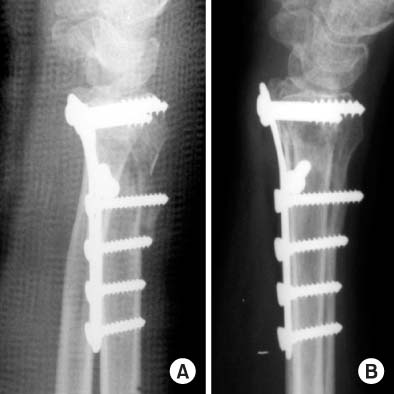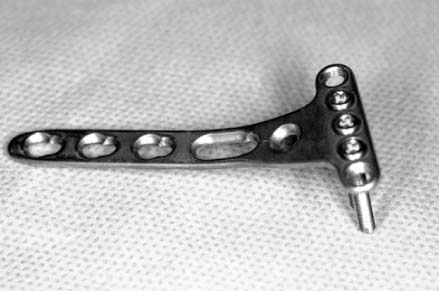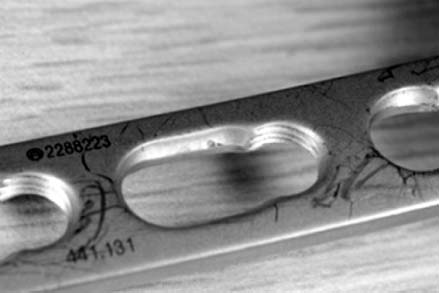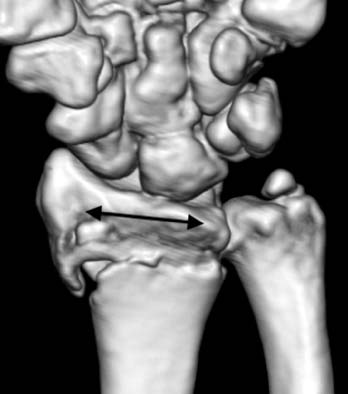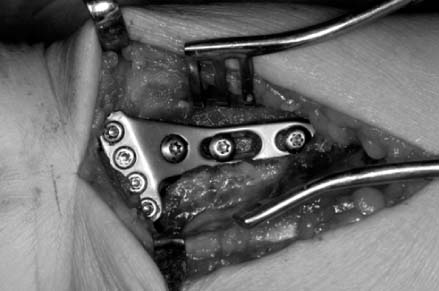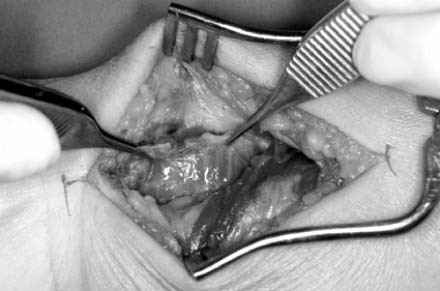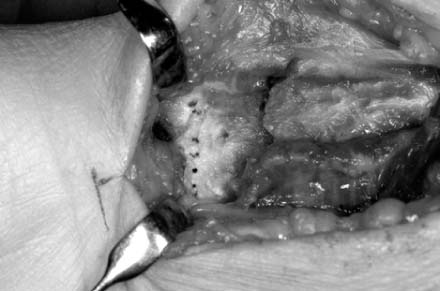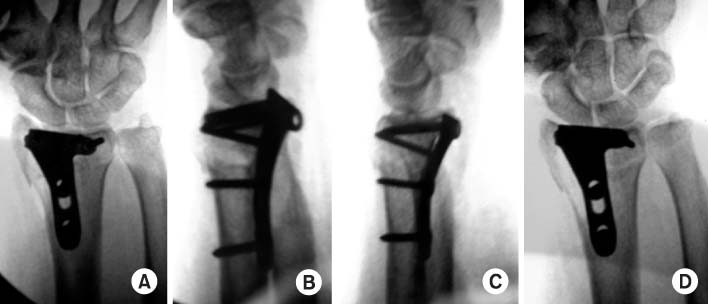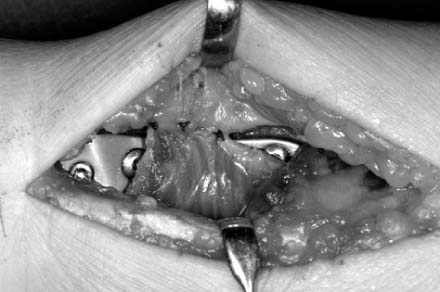Volar Plating of Distal Radius Fractures
- Affiliations
-
- 1Department of Orthopedic Surgery, Hanyang University Hospital, Seoul, Korea. leegh@hanyang.ac.kr
- KMID: 1480924
- DOI: http://doi.org/10.12671/jkfs.2008.21.4.325
Abstract
- Volar plating seems to indicate that many surgeons believe it leads to superior results, and is attractive because of the ease of the operative approach and the soft tissue sleeve to protect digital and wrist tendons. And also it have a locking mechanism to produce the fixed angle device with a low profile and may be thought to be a new era in the surgical treatment of dorsally displaced distal radius fractures even in the face of comminuted or osteoporotic bone. Locked volar plating allows direct fracture reduction, stable fixation and provides stability enough to allow early mobilization and function. The results with volar locking or fixed angle fixation for the general treatment of unstable distal radius fractures in elderly patients has been favorable. Volar plating has fewer complications than external fixation and dorsal plating and allow for earlier return to function. The current indications, technical aspects, clinical results, and complications of the volar plating are being reviewed.
Figure
Cited by 5 articles
-
Short Term Results of Operative Management with 2.4 mm Volar Locking Compression Plates in Distal Radius Fractures
Ki-Chul Park, Chang-Hun Lee
J Korean Fract Soc. 2009;22(4):264-269. doi: 10.12671/jkfs.2009.22.4.264.Treatment for Unstable Distal Radius Fracture with Osteoporosis -Internal Fixation versus External Fixation-
Jin Rok Oh, Tae Yean Cho, Sung Min Kwan
J Korean Fract Soc. 2010;23(1):76-82. doi: 10.12671/jkfs.2010.23.1.76.Comparison of Operative Management in Distal Radius Fractures Using 3.5 mm Versus 2.4 mm Volar Locking Compression Plates
Sung-Sik Ha, Tae-Ho Kim, Ki-Do Hong, Jae-Chun Sim, Jong Hyun Kim
J Korean Fract Soc. 2011;24(2):156-162. doi: 10.12671/jkfs.2011.24.2.156.The Fate of Pronator Quadratus Muscle after Volar Locking Plating of Unstable Distal Radius Fractures
Chae-Hyun Lim, Heun-Guyn Jung, Ju-Yeong Heo, Young-Jae Jang, Yong-Soo Choi
J Korean Fract Soc. 2014;27(3):191-197. doi: 10.12671/jkfs.2014.27.3.191.Ultrasonographic Assessment of the Pronator Quadratus Muscle after Surgical Treatment for Distal Radius Fractures
Dong Hyuk Choi, Hyun Kyun Chung, Ji Won Lee, Cheol Hwan Kim, Yong Soo Choi
J Korean Fract Soc. 2017;30(2):69-74. doi: 10.12671/jkfs.2017.30.2.69.
Reference
-
1. Arora R, Lutz M, Hennerbichler A, Krappinger D, Espen D, Gabl M. Complications following internal fixation of unstable distal radius fracture with a palmar locking-plate. J Orthop Trauma. 2007; 21:316–322.
Article2. Baratz ME, Des Jardins J, Anderson DD, Imbriglia JE. Displaced intra-articular fractures of the distal radius: the effect of fracture displacement on contact stresses in a cadaver model. J Hand Surg Am. 1996; 21:183–188.
Article3. Cho CH, Bae KC, Kwon DH. Volar T-locking compression plate for treatment of unstable distal radius fractures. J Korean Fract Soc. 2008; 21:220–224.
Article4. Choi CH, Jung JH, Lee KH, Sung IH, Son KH. Volar locking T-plate fixation of dorsally displaced unstable distal radius fractures. J Korean Soc Surg Hand. 2005; 10:123–128.5. Disegi JA, Wyss H. Implant materials for fracture fixation: a clinical perspective. Orthopedics. 1989; 12:75–79.
Article6. Freeland AE, Luber KT. Biomechanics and biology of plate fixation of distal radius fractures. Hand Clin. 2005; 21:329–339.
Article7. Gehrmann SV, Windolf J, Kaufmann RA. Distal radius fracture management in elderly patients: a literature review. J Hand Surg Am. 2008; 33:421–429.
Article8. Gerald G, Karl G, Christian G, et al. Volar plate fixation of AO type C2 and C3 distal radius fractures, a single-center study of 55 patients. J Orthop Trauma. 2008; 22:467–472.
Article9. Gesensway D, Putnam MD, Mente PL, Lewis JL. Design and biomechanics of a plate for the distal radius. J Hand Surg Am. 1995; 20:1021–1027.
Article10. Haidukewych GJ. Innovations in locking plate technology. J Am Acad Orthop Surg. 2004; 12:205–212.
Article11. Lee KH. Clinical biomechanics of the locking plate. J Korean Fract Soc. 2008; 21:186–188.
Article12. McKay SD, MacDermid JC, Roth JH, Richards RS. Assessment of complications of distal radius fractures and development of a complication checklist. J Hand Surg Am. 2001; 26:916–922.
Article13. Muller M, Allgower M, Schneider R, Willenegger H. Manual of internal fixation. 3rd ed. New York: Springer Verlag;1991. p. 1–3.14. Nam IH, Ahn GY, Jang JH, Lee JW, Yun HH. Surgical treatment of dorsally displaced unstable distal radius fracture with volar plate fixation. J Korean Orthop Assoc. 2005; 40:814–820.
Article15. Orbay J. Volar plate fixation of distal radius fractures. Hand Clin. 2005; 21:347–354.
Article16. Orbay JL. The treatment of unstable distal radius fractures with volar fixation. Hand Surg. 2000; 5:103–112.
Article17. Osada D, Kamei S, Masuzaki K, Takai M, Kameda M, Tamai K. Prospective study of distal radius fractures treated with a volar locking plate system. J Hand Surg Am. 2008; 33:691–700.
Article18. Peterson ED, Dennison DG. Fixed-angle volar plate fixation for distal radius fractures in immunosuppressed patients. Hand (NY). 2008.
Article19. Pichon H, Chergaoui A, Jager S, et al. Volar fixed angle plate LCP 3.5 for dorsally distal radius fracture. About 24 cases. Rev Chir Orthop Reparatrice Appar Mot. 2008; 94:152–159.20. Putnam MD, Seitz WH Jr. Advances in fracture management in the hand and distal radius. Hand Clin. 1989; 5:455–470.
Article21. Rozental TD, Blazar PE. Functional outcome and complications after volar plating for dorsally displaced, unstable fractures of the distal radius. J Hand Surg Am. 2006; 31:359–365.
Article22. Stein H, Perren SM, Cordey J, Kenwright J, Mosheiff R, Francis MJ. The muscle bed--a crucial factor for fracture healing: a physiological concept. Orthopedics. 2002; 25:1379–1383.
Article23. Strauss EJ, Banerjee D, Kummer FJ, Tejwani NC. Evaluation of a novel, nonspanning external fixator for treatment of unstable extra-articular fractures of the distal radius: biomechanical comparison with a volar locking plate. J Trauma. 2008; 64:975–981.
Article24. Yamazaki H, Hattori Y, Doi K. Delayed rupture of flexor tendons caused by protrusion of a screw head of a volar plate for distal radius fracture: a case report. Hand Surg. 2008; 13:27–29.
Article
- Full Text Links
- Actions
-
Cited
- CITED
-
- Close
- Share
- Similar articles
-
- Delayed Rupture of Flexor Pollicis Longus after Volar Plating for a Distal Radius Fracture
- Treatment of Fractures of the Distal Radius using Locking Compression Plate
- Relationship between the Length of Distal Locking Screws and Diaphyseal Screws in Volar Plate Fixation of Distal Radius Fractures
- The Anterior-Posterior Diameter of Radial Shaft for Predicting Appropriate Length of Distal Screws in Volar Plating for Distal Radius Fractures
- Failure of Distal Locking Screws in an Intraarticular Distal Radius Fracture Treated with Volar Locking Plate Fixation


